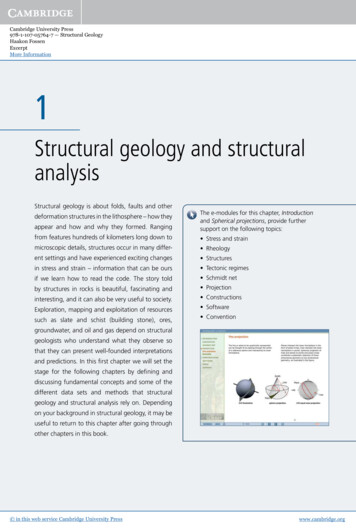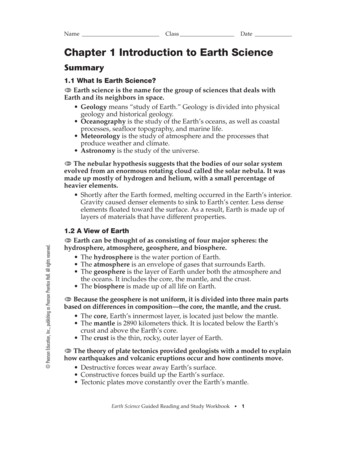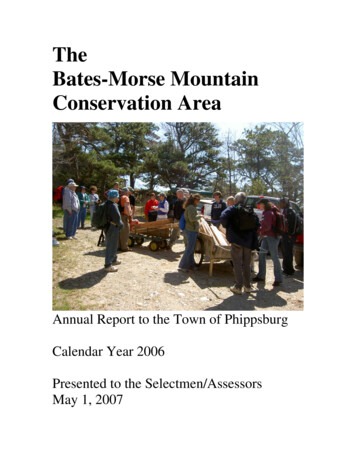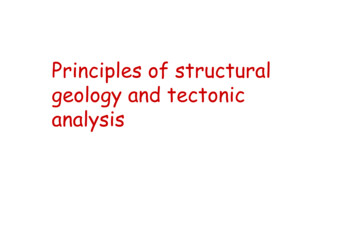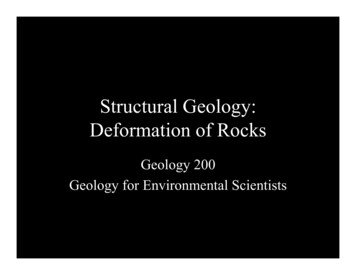
Transcription
Structural Geology:Deformation of RocksGeology 200Geology for Environmental Scientists
Major Concepts Folds in rocks range from microscopic tohundreds of kilometers across. Faults are fractures along whichdisplacement has occurred. Joints are fractures where there has been nodisplacement. Rocks deform when applied stress exceedsrock strength. Deformation may be ductileflow or brittle fracture.
Folds anticlines and synclines - plunge outeventually, don’t go on forever domes and basins - very broad featureswithin continental interiors complex folds - the result of very ductilebehavior
Fig. 7.11. Types of folds
Fig. 7.15a. A series of anticlines & synclinesin southern California
Anticline-syncline fold pair in SW Wales
Faults: 3 major categories normal faults - caused by extension ortension thrust faults and reverse faults - caused bycompression strike-slip or tear faults - caused by lateralshear
Normal faultThrust faultStrike-slip fault
In both normal and reverse faults the hangingwall is above the footwall. Miners followingmineral veins would walk down the footwall andhang their lanterns on the hanging wall.
Strike and Dip Describes the orientations of beddingplanes, faults, or joints. Strike - compass bearing of a horizontal lineon a plane Dip - the inclination of a plane from thehorizontal. Dip direction is always at aright angle to the strike. See Fig. 7.5 in your book.
Fig. 7.5.Strike & Dip
A graphic representation of the concept of strikeand dip of bedded rocks.
Pattern of strikes and dips for a syncline.
Fold Nomenclature anticlines - rocks older in the centersynclines - rocks younger in the centerlimbshinge and hinge plane or axial planeplunge
Fig. 7.12. Fold geometry
Examples of horizontaland plunging fold axes.
Asymmetrical Fold atGeology Field Camp in SD
Orogenic belt with complex folding
Fig. 7.15d. A plunging anticline in southern Utah
Plunging anticline, Montana
Plunging anticline, Montana
Anticline in the Keefer Sandstone of WV
Open fold in the Tuscarora Sandstone, WVUGeology Field Camp
Overturned folds: anticline-syncline pair in thecore of an ancient mountain system, SouthGeorgia Island
Isoclinal folds along the coast of Maine
Isoclinal folds along the coast of Maine
Chevron folds in brittle rocks. Anexample of angle parallel folding.
Angle parallel or kinkfolds in Italy
Domes and Basins Very large features with gentle dips, usuallyonly visible on geologic maps (too large torecognize on the ground). Restricted to continental interiors. Examples include the Michigan Basin,Illinois Basin, Cincinnati Arch, NashvilleDome, Black Hills, etc.
The Black Hills of South Dakota are a structural dome.
Geologic Mapof the BlackHills of SouthDakota
Fig. 7.15b. A small dome in Texas
Michigan Basin
Geologic Map of Michigan Basin
Complex Folds Formed by intense deformation in mountainranges. Usually the result of multiple episodes offolding. The folds themselves may be folded andthey are often recumbent. Can be at any scale from outcrop to mapscale.
Complex folds in sandstone, Cornwall, UK
Recumbent isoclinal folds in meta-sediments,Scotland
Complex folding in1.2 Ga meta-sediments,Adirondack Mtns. ofNew York
Complex,disharmonicfolds in ductilerocks.
Ptygmatic folds of migmatite inmetamorphic rocks, Spain
Fig. 7.7. Major types of faults
Fig. 7.8a. Easily recognized displacement
Fig. 7.8a. Easily recognized displacement
Normal faults
Extension experiment in tectonicmodeling lab exercise
Extension experiment in tectonicmodeling lab exercise
The Mid-Atlantic Ridge in Iceland. Note the faultscarps and tilted fault blocks caused by extension.
Fig. 7.8b. Normal faults produce grabens & horsts
Small scale listric normal faulting caused by gravitysliding. The faults becomes horizontal at depth. Canyou recognize the fault planes?
Small scale faulting in soft sediments, both normaland reversed. Notice the horsts and grabens.
Thrust faulting
Types of Thrust Faults Fault bend folds - fault forms before thefold; deformation restricted to the hangingwall Fault propagation folds - fault forms alongwith the folding; deformation in both thehanging wall and foot wall
Example of a fault-bend fold thrust fault at the WVUGeology Field Camp. Cross-sections from Thorbjornsenand Dunne, 1997.
Fault propagation folds, backthrusts, and pop-up structure.Yukon River near Eagle, Alaska.Thrust direction
Compression experiment in tectonicmodeling lab exercise
Compression experiment in tectonicmodeling lab exercise
Thrust faults seen on a seismic lineacross an oil field.
Thrust faulting: a fault propagation fold.
Folded soil layer along a lake in Wisconsin caused by thrusting ofice on shore by high winds during spring thaw. Note theformation of the fault propagation fold and the anticline coreexposed in the background by a tear fault.
A fault in the GrandCanyon. Precambrianrocks on the left,Paleozoic rocks on theright. What type offault is this?
Fault scarp along the coast of Wales. What is thedirection of motion? What type of fault is this?
Fault scarp in the California desert. What is thedirection of motion? What type of fault is this?
Strike-slip fault, San Andreas Fault,California
Fig. 7.8e. Strike-slip faults offset drainage,San Andreas Fault, California
August 17, 1999 earthquake in Turkey.7.8 on the Richter scale. The fault is astrike-slip fault between the Arabianand European plates.
August 17, 1999 earthquake in Turkey -rapid, brittle deformation
August 17, 1999 earthquake in Turkey -rapid, brittle deformation
Joints Fractures in rocks with no appreciabledisplacement. They are very common in allrocks. Such joints are often zones of weaknesswhere later faults could develop. Fluids can travel along joints: water,petroleum, pollution valuable metal ores may form along jointsfrom hydrothermal solutions.
Devil’s Tower, Wyoming
Columnar joints in volcanic rock
Exfoliation: horizontal joints formed bysheeting as overburden pressure is released.
Causes of Rock Deformation Stress - pressure placed on rocksStrain - deformation of the rockStrength - rock resistance to deformationBrittle deformation - the rocks break orfracture. Occurs at low temperatures andlow pressures. Ductile deformation - the rocks bend orflow. Occurs at higher temperature andpressures.
Compression of a rock cylinder: left - uncompressed;center - confined pressure, ductile deformation; right unconfined pressure, brittle deformation
Figure 7.2 – Brittle vs. ductile behavior of rock
Strain indicators fault offsettension gashesfracturesductile flow
Right-lateraldisplacement alongstrike-slip fault,Hayward, CA. Curbunderwent brittlerupture whereas asphaltfailed by a series of enechelon tension gashes.
Tension gashes in limestone filled with calcite.Motion is left lateral. Gashes are S-shaped.
En echelon sigmoidal veins in a brittle-ductile shearzone. Motion is right lateral. Gashes are Z-shaped.
Lithologic control on deformation. Thedolostone shows brittle deformation whereas thesurrounding limestone was ductilely deformed.
Effect of bed thickness on ductile flow. Thicker bed oflimestone folded, whereas thin beds were squeezed out ofthe fold cores (curved nonparallel folding).
Boudinage in a granitic sill intruded into schist.An example of ductile flow.
See Fig. 7.5 in your book. Fig. 7.5. Strike & Dip. A graphic representation of the concept of strike and dip of bedded rocks. Pattern of strikes and dips for a syncline. . formation of the fault propagation fold and the anticline core exposed in the background
